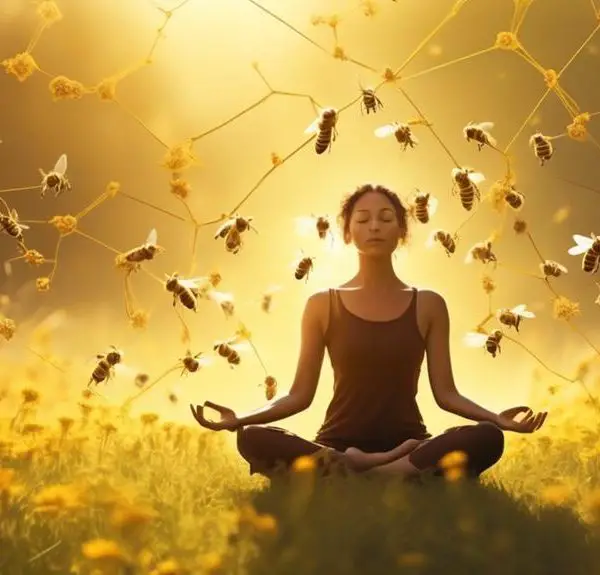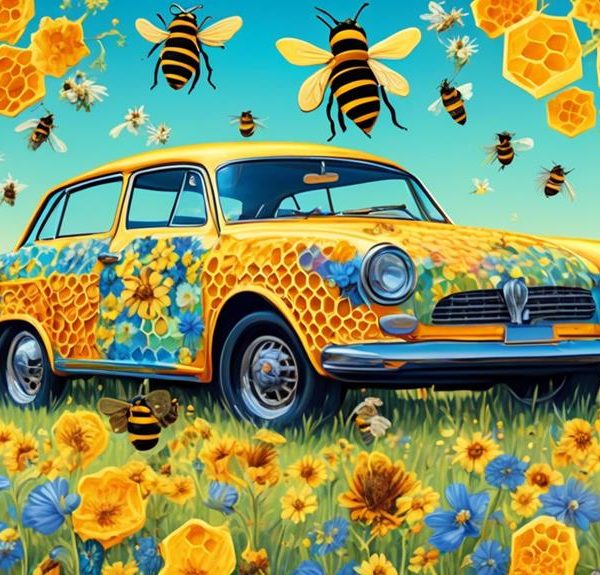Just why are bee suits white? Uncover the intriguing science behind this choice and how it impacts a bee's behavior.
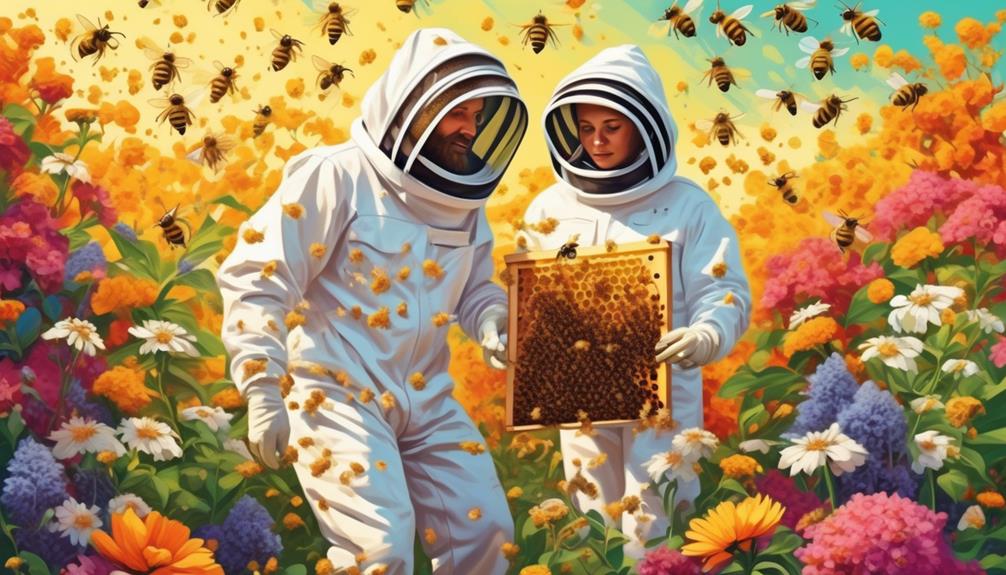
Why Are Bee Suits White?
You've probably wondered why beekeepers don't sport a more fashionable color for their attire, haven't you? No, it's not a fashion faux pas or a lack of creativity. The choice of white for bee suits is both scientific and practical.
Bees, unlike humans, perceive colors differently due to their unique vision. White, in the bee world, is a far less threatening color than darker shades. It's a fascinating topic, as you explore the reasons why a simple color choice can be the difference between a peaceful hive and an aggressive swarm.
But this is just the tip of the iceberg, there's a whole scientific explanation waiting for you to unravel.
Key Takeaways
- Bees perceive colors differently from humans, unable to see red but sensitive to ultraviolet.
- Bees are more responsive to blues and violets, which are common colors of flowers.
- White suits are less likely to provoke an aggressive response from bees and promote better health and productivity.
- White suits offer practical advantages such as visibility, comfort, safety, and hygiene in effective beekeeping.
Understanding Bee Vision
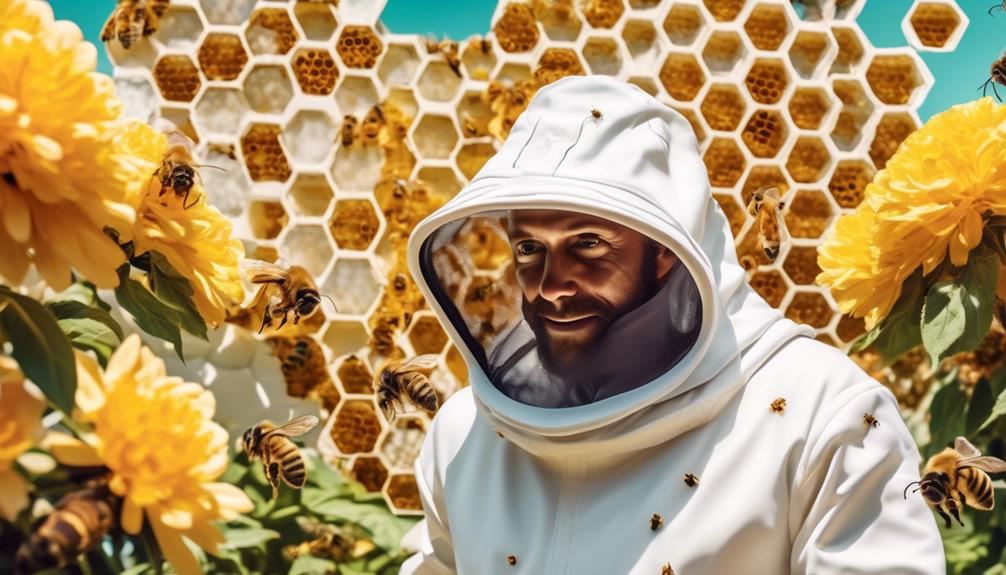
To comprehend why bee suits are typically white, you first need to understand how bees perceive color and light. Unlike humans, bees can't see the color red but can distinguish ultraviolet, a color humans can't detect. This difference in perception is due to the unique structure of a bee's compound eyes, which are more sensitive to blue and green wavelengths.
In the realm of bees, colors aren't just visual stimuli. They're signals that guide their behavior. Bright colors, especially floral hues, are like neon signs pointing to nectar, their primary food source. So, how does this relate to the color of bee suits?
Since bees associate darker colors with their natural predators like bears and skunks, they're more likely to be aggressive towards dark objects. Consequently, beekeepers wear white suits to minimize the risk of bee attacks. The light color doesn't alarm bees as much and helps keep them calm, increasing safety for both the beekeeper and the bees.
In essence, understanding bee vision is key to deciphering the puzzle of white bee suits. It's a fascinating example of how human practices adapt to the intricate workings of nature.
The Color Spectrum and Bees
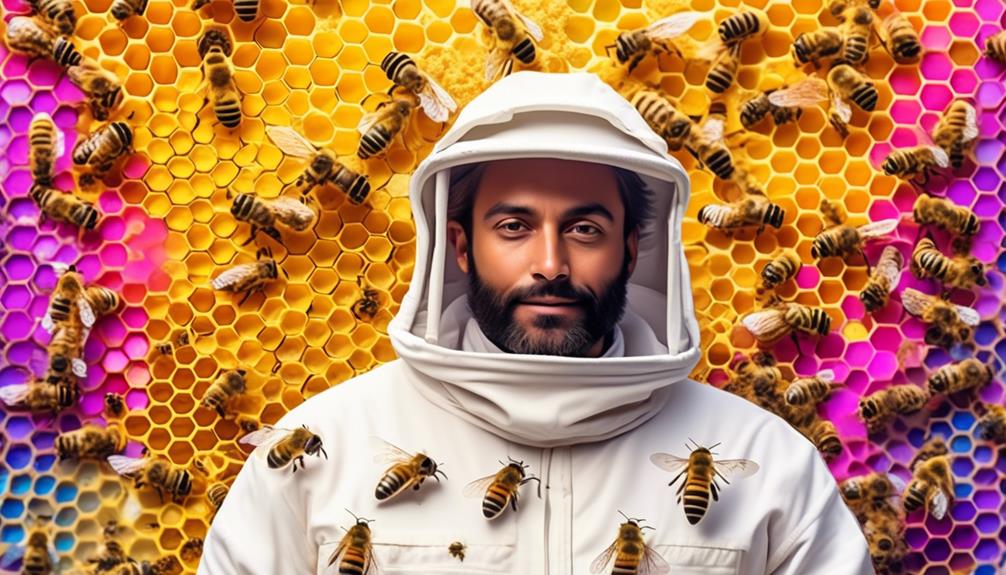
Diving deeper into the world of bees, you'll find that their perception of the color spectrum plays a pivotal role in their daily activities and interactions. Unlike humans, bees can't see the color red. Their vision is shifted towards the ultraviolet end of the spectrum, which reveals a world invisible to us.
Bees are drawn to blues and violets, which are common colors of many flowers. They're also attracted to UV patterns that some flowers produce, creating a 'bullseye' effect that guides them to the nectar. It's a fascinating adaptation, a kind of secret language between bees and flowers.
However, they're less responsive to colors like white, yellow, and green. These colors blend into the background for them. Beekeepers exploit this feature when choosing their suit color. White doesn't stand out in the bees' color spectrum, making beekeepers less of a target. They're effectively 'invisible' to the bees, minimizing the risk of aggressive encounters.
Significance of White in Beekeeping
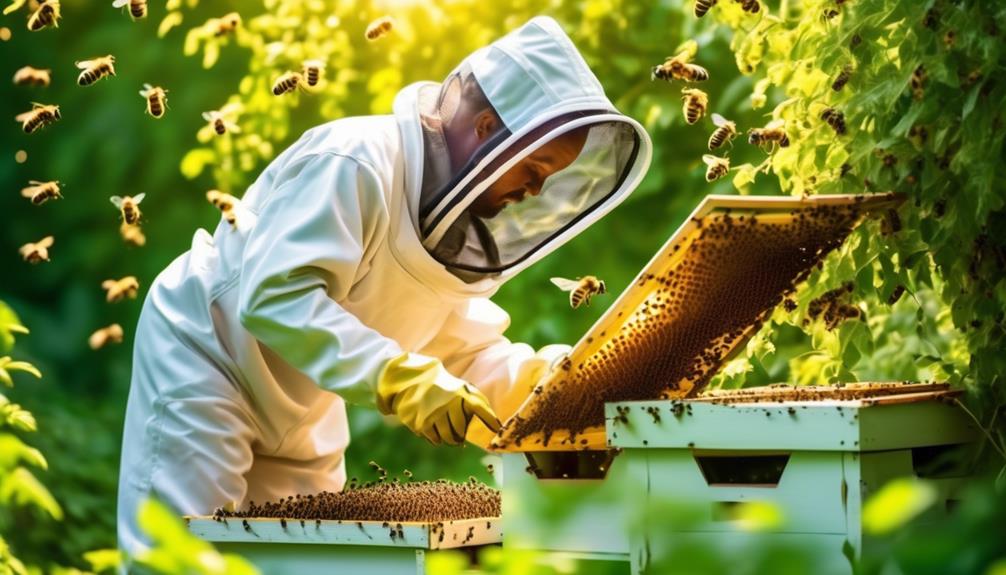
Exploiting the bees' unique perception of color, beekeepers have long favored white for their protective suits, a choice that holds significant implications in the realm of beekeeping. You see, bees don't see white as a threatening color. Instead, they associate it with the natural world, the color of their hives, and the flowers they frequent.
So, when you're clad in white, you're less likely to provoke an aggressive response. The bees don't see you as a predator but rather a part of their environment, which means they're less likely to attack. This doesn't just make beekeeping safer, it also minimizes stress for the bees, promoting better health and productivity in the hive.
Moreover, white reflects sunlight and heat, keeping you cooler during those hot summer months. This is crucial as overheating can lead to heatstroke, a serious risk for beekeepers working long hours in the sun.
In essence, the choice of white isn't arbitrary. It's a strategic decision, designed to ensure safety, increase productivity, and maintain the wellbeing of both the beekeeper and the bees. It's a testament to the depth of understanding and respect beekeepers have for these remarkable creatures.
Practical Advantages of White Suits
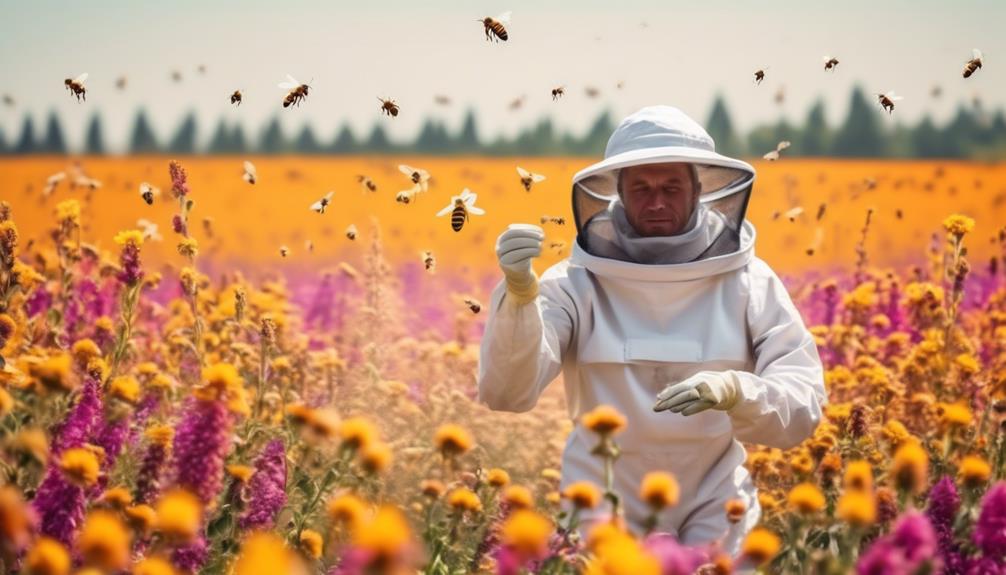
Beyond the bee's perception of color, white bee suits offer practical benefits that enhance your beekeeping experience.
For starters, they help you stand out in the apiary. Unlike bees, you don't blend into the natural environment. White suits make you highly visible, reducing the chance of accidental bumps and collisions.
They're also highly reflective. On hot, sunny days, a white suit reflects a substantial amount of sunlight, keeping you cooler than darker colors that absorb heat. This thermal advantage lets you work longer and more comfortably, even in the height of summer.
Moreover, white suits make bee stings less severe. It's not widely known, but bee stingers can penetrate some fabrics but not others. White suits are often made of smooth, tightly woven material that bees find difficult to sting through.
Lastly, dirt and debris are easily visible on white, allowing you to spot potential contaminants or pests hitching a ride on your suit.
In short, the practical advantages of white bee suits go beyond mere color preferences. They're designed for visibility, comfort, safety, and hygiene – all crucial aspects of effective beekeeping.
Bee Suit Alternatives and Experiments
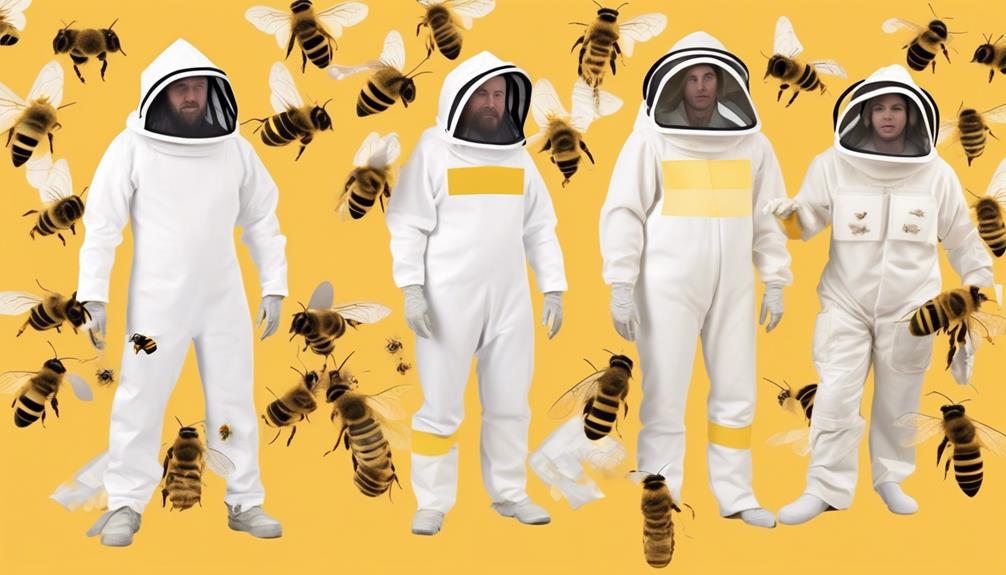
While white bee suits are the traditional choice for beekeepers, there's ongoing research into alternatives and modifications that could enhance beekeeping safety and efficiency. For instance, you could consider suits made of lighter, breathable materials that reduce heat stress without compromising protection. There's also the option of suits with better visibility, such as those with clear-view fencing veils.
In terms of color, experiments are being conducted on whether bees react differently to other shades. Some have suggested that blue or green suits might be less provocative to bees, but solid scientific evidence is yet to back this hypothesis.
Furthermore, design modifications have come into play. Suits with easy-access pockets, elasticated cuffs and waists, and removable veils offer practicality and flexibility for beekeepers. Some designs even feature built-in gloves and boots for additional safety.
Lastly, technological advancements present intriguing possibilities. Imagine a suit embedded with sensors to monitor bee behavior or health indicators. Such innovations could revolutionize the industry.
Frequently Asked Questions
What Materials Are Commonly Used in Making Bee Suits?"
You're likely to find bee suits made from a variety of materials. These typically include cotton, polyester, or a blend of both. The material's often thick to prevent stings but breathable for comfort. They may also have a ventilated foam layer for extra protection.
It's crucial that these suits are durable and easy to clean since beekeeping can be a messy job. Remember, the choice of material can significantly impact your beekeeping experience.
Are There Other Protective Gears Needed in Beekeeping Aside From the Suit?"
Absolutely, other protective gear is crucial to beekeeping alongside the suit. You'll need a good pair of gloves to safeguard your hands from stings.
A beekeeper's hat and veil are also essential to protect your face and neck.
You might consider beekeeping boots too, to ensure bees can't crawl up your legs.
Lastly, a hive tool is indispensable for managing your hive.
How Often Should Bee Suits Be Cleaned or Maintained?"
You should clean your bee suit after every few uses, or immediately if it's heavily soiled. Regular cleaning helps to remove any pheromones that can trigger bee aggression.
It's vital to follow the manufacturer's instructions to prevent damaging the suit. Don't forget to check and repair any loose seams or tears.
Proper maintenance ensures the longevity of your bee suit and guarantees your protection against bee stings.
Are There Any Potential Risks or Hazards Associated With Wearing a Bee Suit?"
Sure, wearing a bee suit does come with some risks. It can be hot, restricting your movement and causing heat exhaustion. You're also not entirely immune to stings. Bees can potentially sting through the suit or find gaps, especially around the wrists and ankles.
Plus, if you aren't careful when taking it off, you could inadvertently release trapped bees. So, always check your suit for any trapped bees and ensure it fits properly.
Can Bee Suits Be Customized and in What Ways?"
Yes, you can customize your bee suit. You're able to add pockets or extra padding for comfort. You might opt for a veil that suits your preference, like a round or fencing style.
There's also the choice of suit material, such as cotton or a synthetic blend. However, it's essential to remember that your suit's primary purpose is to protect you, so all customizations shouldn't compromise your safety.
Conclusion
So, why are bee suits white?
It's all about bee vision and the color spectrum. Bees perceive white as a non-threatening color, unlike darker shades.
This, combined with the practical advantages like heat reflection, makes white the go-to color for bee suits.
But remember, while white is standard, it's not the only option. There's ongoing research into other colors and materials for bee suits.
Stay tuned for more beekeeping innovations!

